Abstract
1. The non-selective adenosine agonist, 5'-N-ethylcarboxamidoadenosine (NECA), is a potent inhibitor of morphine withdrawal diarrhoea in rats. More recently we found that NECA exerts its antidiarrhoeal effect by inhibiting secretion in both the jejunum and ileum and also by inhibiting peristalsis in the ileum. The specific aim of this study was to characterize the receptor in the rat jejunum mediating inhibition of peristalsis via functional studies using a range of metabolically stable adenosine analogues based on the pharmacological criteria of relative agonist and antagonist potencies. 2. Peristalsis in the rat isolated jejunum was achieved by raising the pressure to between 7-11 cmH2O for 3 min followed by a 3 min rest period (pressure at zero). The mean rate of peristalsis during inflation was 7.3 +/- 0.1 peristaltic waves per 3 min and this rate remained consistent for up to 30 min, in 5 separate tissues. The inhibitory effects of the adenosine analogues were quantified by expressing their effects as a % reduction in the mean number of peristaltic contractions derived from the control tissues. 3. The rank order of agonist potency to reduce the rate of peristalsis was: N6-cyclopentyladenosine (CPA) > NECA > R(-)-N6-(2-phenylisopropyl)adenosine (R-PIA) > chloroadenosine (2-CADO) > S-PIA > 2-phenylaminoadenosine (CV-1808). This order complies well with the rank order of agonist potency that represents the activation of the A1 receptor subtype (CPA > R-PIA = CHA = > NECA > 2-CADO > S-PIA > CV-1808).(ABSTRACT TRUNCATED AT 250 WORDS)
Full text
PDF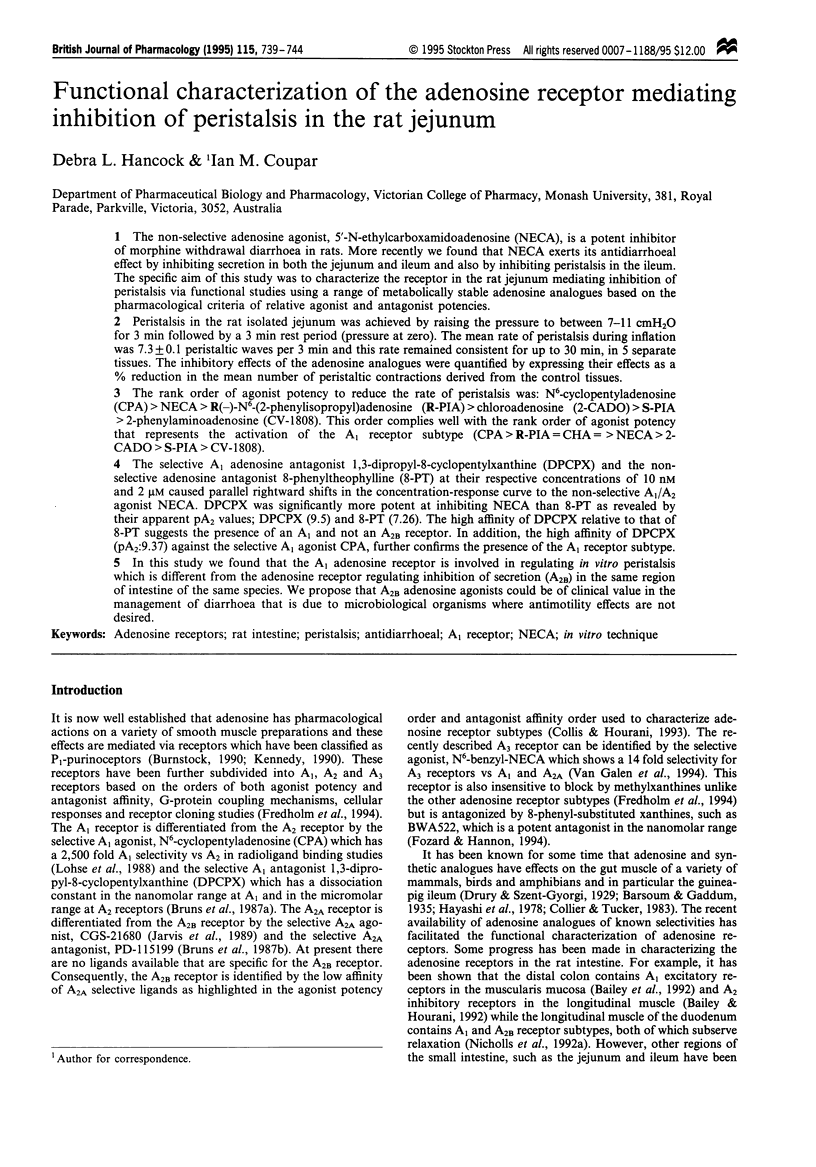
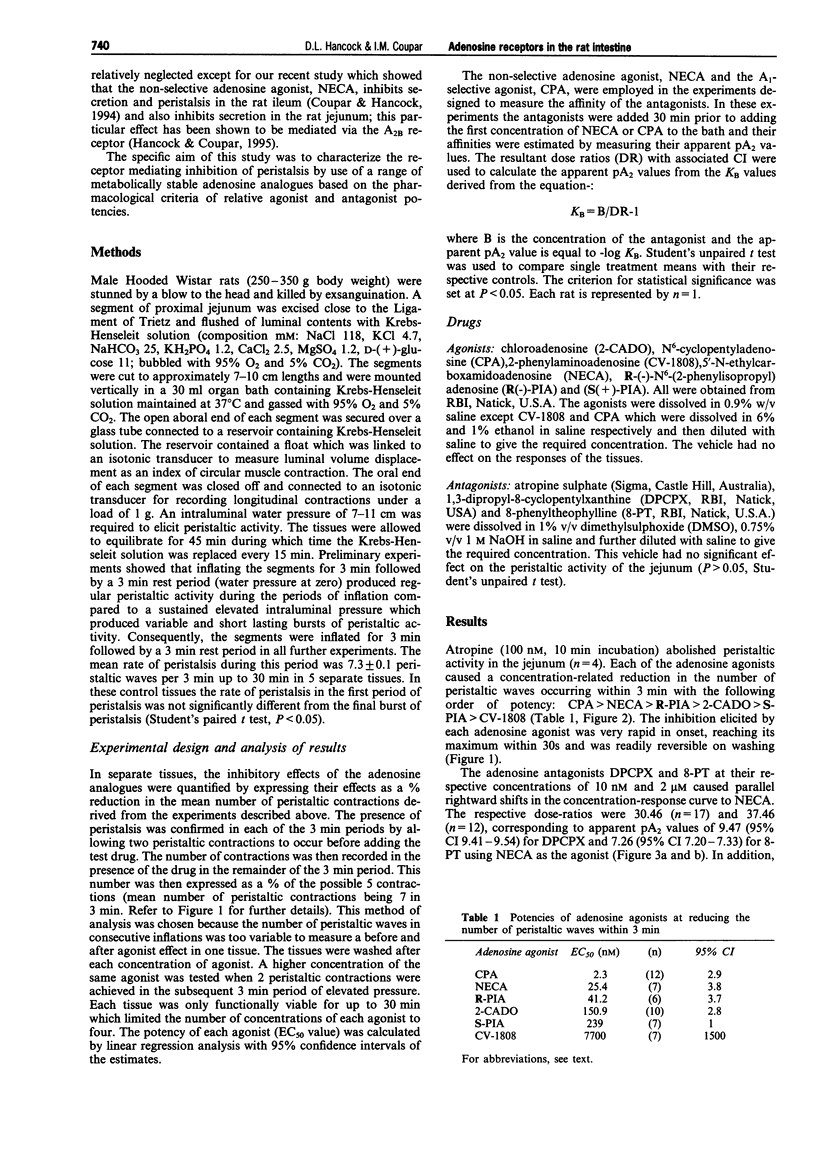
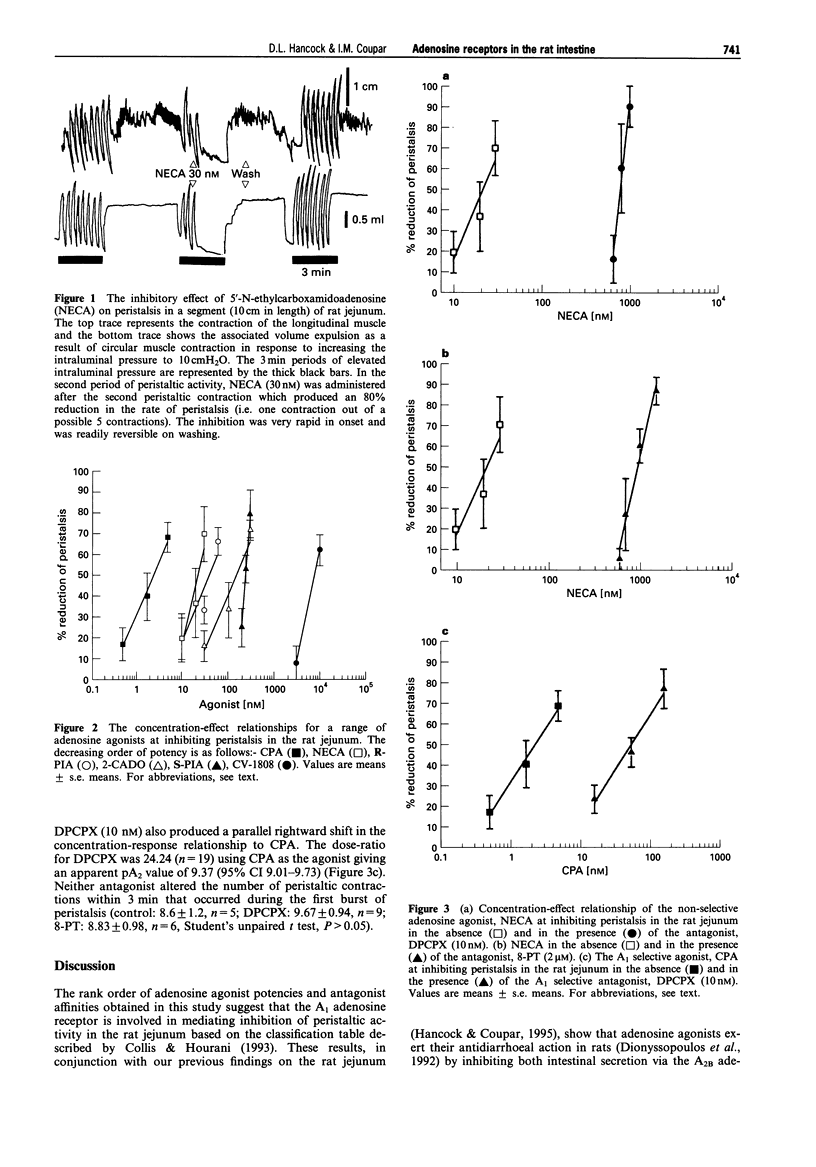

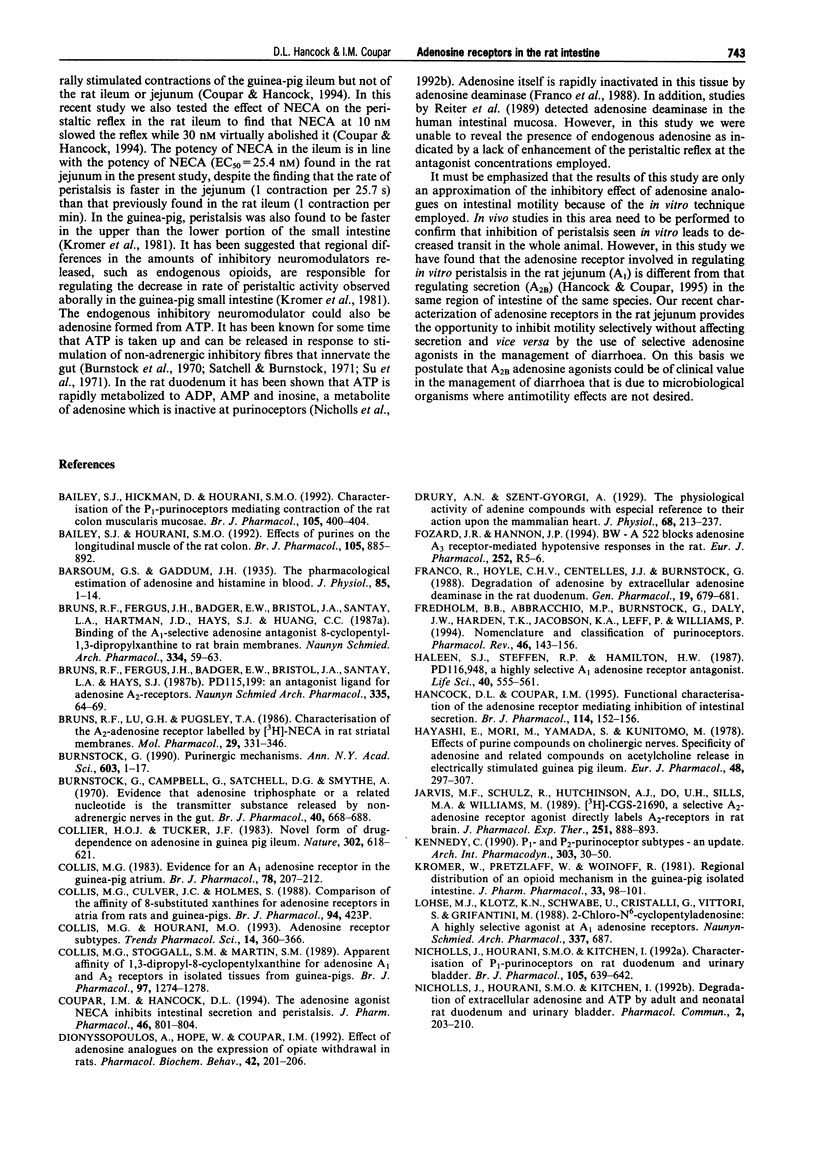
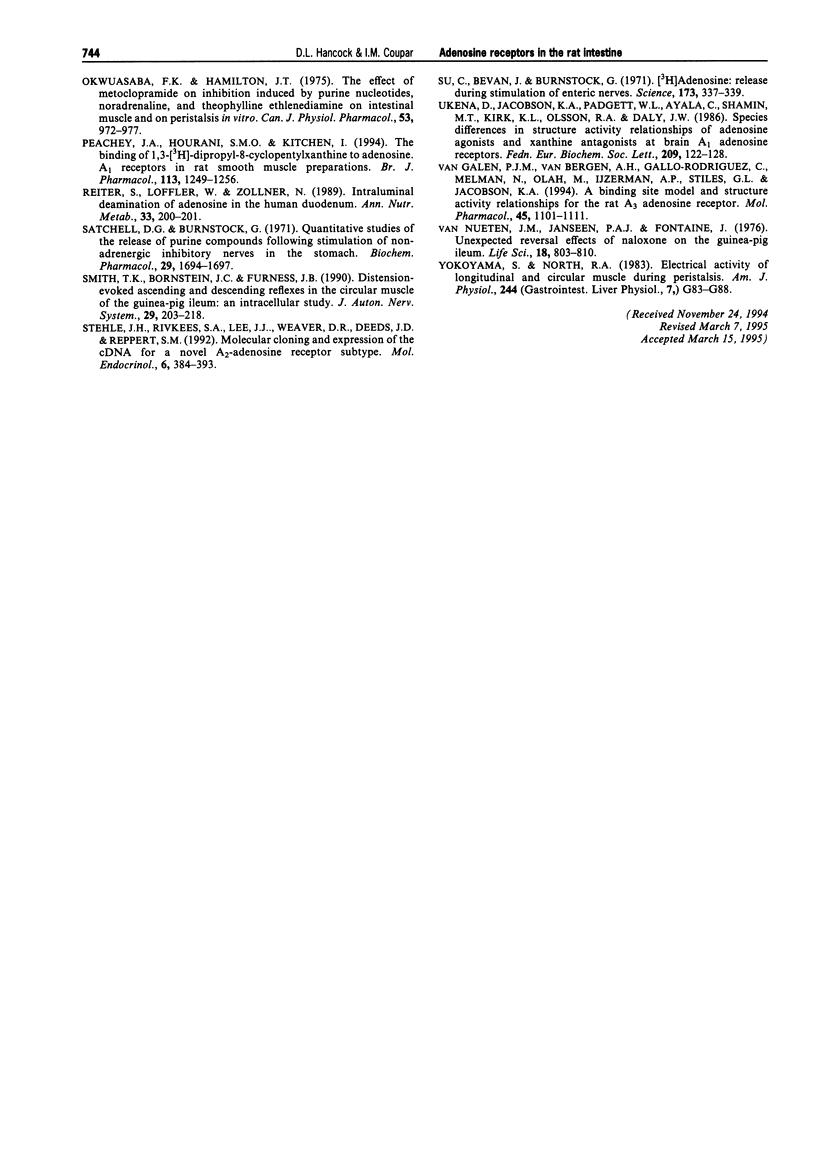
Selected References
These references are in PubMed. This may not be the complete list of references from this article.
- Bailey S. J., Hickman D., Hourani S. M. Characterization of the P1-purinoceptors mediating contraction of the rat colon muscularis mucosae. Br J Pharmacol. 1992 Feb;105(2):400–404. doi: 10.1111/j.1476-5381.1992.tb14265.x. [DOI] [PMC free article] [PubMed] [Google Scholar]
- Bailey S. J., Hourani S. M. Effects of purines on the longitudinal muscle of the rat colon. Br J Pharmacol. 1992 Apr;105(4):885–892. doi: 10.1111/j.1476-5381.1992.tb09073.x. [DOI] [PMC free article] [PubMed] [Google Scholar]
- Barsoum G. S., Gaddum J. H. The pharmacological estimation of adenosine and histamine in blood. J Physiol. 1935 Aug 22;85(1):1–14. doi: 10.1113/jphysiol.1935.sp003298. [DOI] [PMC free article] [PubMed] [Google Scholar]
- Bruns R. F., Fergus J. H., Badger E. W., Bristol J. A., Santay L. A., Hays S. J. PD 115,199: an antagonist ligand for adenosine A2 receptors. Naunyn Schmiedebergs Arch Pharmacol. 1987 Jan;335(1):64–69. doi: 10.1007/BF00165038. [DOI] [PubMed] [Google Scholar]
- Bruns R. F., Lu G. H., Pugsley T. A. Characterization of the A2 adenosine receptor labeled by [3H]NECA in rat striatal membranes. Mol Pharmacol. 1986 Apr;29(4):331–346. [PubMed] [Google Scholar]
- Burnstock G., Campbell G., Satchell D., Smythe A. Evidence that adenosine triphosphate or a related nucleotide is the transmitter substance released by non-adrenergic inhibitory nerves in the gut. Br J Pharmacol. 1970 Dec;40(4):668–688. doi: 10.1111/j.1476-5381.1970.tb10646.x. [DOI] [PMC free article] [PubMed] [Google Scholar]
- Burnstock G. Overview. Purinergic mechanisms. Ann N Y Acad Sci. 1990;603:1–18. doi: 10.1111/j.1749-6632.1990.tb37657.x. [DOI] [PubMed] [Google Scholar]
- Collier H. O., Tucker J. F. Novel form of drug-dependence--on adenosine in guinea pig ileum. Nature. 1983 Apr 14;302(5909):618–621. doi: 10.1038/302618a0. [DOI] [PubMed] [Google Scholar]
- Collis M. G. Evidence for an A1-adenosine receptor in the guinea-pig atrium. Br J Pharmacol. 1983 Jan;78(1):207–212. doi: 10.1111/j.1476-5381.1983.tb09381.x. [DOI] [PMC free article] [PubMed] [Google Scholar]
- Collis M. G., Hourani S. M. Adenosine receptor subtypes. Trends Pharmacol Sci. 1993 Oct;14(10):360–366. doi: 10.1016/0165-6147(93)90094-z. [DOI] [PubMed] [Google Scholar]
- Collis M. G., Stoggall S. M., Martin F. M. Apparent affinity of 1,3-dipropyl-8-cyclopentylxanthine for adenosine A1 and A2 receptors in isolated tissues from guinea-pigs. Br J Pharmacol. 1989 Aug;97(4):1274–1278. doi: 10.1111/j.1476-5381.1989.tb12589.x. [DOI] [PMC free article] [PubMed] [Google Scholar]
- Coupar I. M., Hancock D. L. The adenosine agonist NECA inhibits intestinal secretion and peristalsis. J Pharm Pharmacol. 1994 Oct;46(10):801–804. doi: 10.1111/j.2042-7158.1994.tb03733.x. [DOI] [PubMed] [Google Scholar]
- Dionyssopoulos T., Hope W., Coupar I. M. Effect of adenosine analogues on the expression of opiate withdrawal in rats. Pharmacol Biochem Behav. 1992 Jun;42(2):201–206. doi: 10.1016/0091-3057(92)90516-i. [DOI] [PubMed] [Google Scholar]
- Drury A. N., Szent-Györgyi A. The physiological activity of adenine compounds with especial reference to their action upon the mammalian heart. J Physiol. 1929 Nov 25;68(3):213–237. doi: 10.1113/jphysiol.1929.sp002608. [DOI] [PMC free article] [PubMed] [Google Scholar]
- Franco R., Hoyle C. H., Centelles J. J., Burnstock G. Degradation of adenosine by extracellular adenosine deaminase in the rat duodenum. Gen Pharmacol. 1988;19(5):679–681. doi: 10.1016/0306-3623(88)90128-0. [DOI] [PubMed] [Google Scholar]
- Fredholm B. B., Abbracchio M. P., Burnstock G., Daly J. W., Harden T. K., Jacobson K. A., Leff P., Williams M. Nomenclature and classification of purinoceptors. Pharmacol Rev. 1994 Jun;46(2):143–156. [PMC free article] [PubMed] [Google Scholar]
- Haleen S. J., Steffen R. P., Hamilton H. W. PD 116,948, a highly selective A1 adenosine receptor antagonist. Life Sci. 1987 Feb 9;40(6):555–561. doi: 10.1016/0024-3205(87)90369-9. [DOI] [PubMed] [Google Scholar]
- Hamel E., Edvinsson L., MacKenzie E. T. Heterogeneous vasomotor responses of anatomically distinct feline cerebral arteries. Br J Pharmacol. 1988 Jun;94(2):423–436. doi: 10.1111/j.1476-5381.1988.tb11544.x. [DOI] [PMC free article] [PubMed] [Google Scholar]
- Hancock D. L., Coupar I. M. Functional characterization of the adenosine receptor mediating inhibition of intestinal secretion. Br J Pharmacol. 1995 Jan;114(1):152–156. doi: 10.1111/j.1476-5381.1995.tb14919.x. [DOI] [PMC free article] [PubMed] [Google Scholar]
- Hayashi E., Mori M., Yamada S., Kumitomo M. Effects of purine compounds on cholinergic nerves. Specificity of adenosine and related compounds on acetylcholine release in electircally stimulated guinea pig ileum. Eur J Pharmacol. 1978 Apr 1;48(3):297–307. doi: 10.1016/0014-2999(78)90088-2. [DOI] [PubMed] [Google Scholar]
- Jarvis M. F., Schulz R., Hutchison A. J., Do U. H., Sills M. A., Williams M. [3H]CGS 21680, a selective A2 adenosine receptor agonist directly labels A2 receptors in rat brain. J Pharmacol Exp Ther. 1989 Dec;251(3):888–893. [PubMed] [Google Scholar]
- Kennedy C. P1- and P2-purinoceptor subtypes--an update. Arch Int Pharmacodyn Ther. 1990 Jan-Feb;303:30–50. [PubMed] [Google Scholar]
- Kromer W., Pretzlaff W., Woinoff R. Regional distribution of an opioid mechanism in the guinea-pig isolated intestine. J Pharm Pharmacol. 1981 Feb;33(2):98–101. doi: 10.1111/j.2042-7158.1981.tb13719.x. [DOI] [PubMed] [Google Scholar]
- Lohse M. J., Klotz K. N., Schwabe U., Cristalli G., Vittori S., Grifantini M. 2-Chloro-N6-cyclopentyladenosine: a highly selective agonist at A1 adenosine receptors. Naunyn Schmiedebergs Arch Pharmacol. 1988 Jun;337(6):687–689. doi: 10.1007/BF00175797. [DOI] [PubMed] [Google Scholar]
- Nicholls J., Hourani S. M., Kitchen I. Characterization of P1-purinoceptors on rat duodenum and urinary bladder. Br J Pharmacol. 1992 Mar;105(3):639–642. doi: 10.1111/j.1476-5381.1992.tb09032.x. [DOI] [PMC free article] [PubMed] [Google Scholar]
- Okwuasaba F. K., Hamilton J. T. The effect of metoclopramide on inhibition induced by purine nucleotides, noradrenaline, and theophylline ethylenediamine on intestinal muscle and on peristalsis in vitro. Can J Physiol Pharmacol. 1975 Oct;53(5):972–977. doi: 10.1139/y75-135. [DOI] [PubMed] [Google Scholar]
- Peachey J. A., Hourani S. M., Kitchen I. The binding of 1,3-[3H]-dipropyl-8-cyclopentylxanthine to adenosine A1 receptors in rat smooth muscle preparations. Br J Pharmacol. 1994 Dec;113(4):1249–1256. doi: 10.1111/j.1476-5381.1994.tb17132.x. [DOI] [PMC free article] [PubMed] [Google Scholar]
- Satchell D. G., Burnstock G. Quantitative studies of the release of purine compounds following stimulation of non-adrenergic inhibitory nerves in the stomach. Biochem Pharmacol. 1971 Jul;20(7):1694–1697. doi: 10.1016/0006-2952(71)90299-1. [DOI] [PubMed] [Google Scholar]
- Smith T. K., Bornstein J. C., Furness J. B. Distension-evoked ascending and descending reflexes in the circular muscle of guinea-pig ileum: an intracellular study. J Auton Nerv Syst. 1990 Mar;29(3):203–217. doi: 10.1016/0165-1838(90)90146-a. [DOI] [PubMed] [Google Scholar]
- Stehle J. H., Rivkees S. A., Lee J. J., Weaver D. R., Deeds J. D., Reppert S. M. Molecular cloning and expression of the cDNA for a novel A2-adenosine receptor subtype. Mol Endocrinol. 1992 Mar;6(3):384–393. doi: 10.1210/mend.6.3.1584214. [DOI] [PubMed] [Google Scholar]
- Ukena D., Jacobson K. A., Padgett W. L., Ayala C., Shamim M. T., Kirk K. L., Olsson R. O., Daly J. W. Species differences in structure-activity relationships of adenosine agonists and xanthine antagonists at brain A1 adenosine receptors. FEBS Lett. 1986 Dec 1;209(1):122–128. doi: 10.1016/0014-5793(86)81096-1. [DOI] [PMC free article] [PubMed] [Google Scholar]
- Van Nueten J. M., Janssen A. J., Fontaine J. Unexpected reversal effects of naloxone on the guinea pig ileum. Life Sci. 1976 Apr 15;18(8):803–809. doi: 10.1016/0024-3205(76)90005-9. [DOI] [PubMed] [Google Scholar]
- Yokoyama S., North R. A. Electrical activity of longitudinal and circular muscle during peristalsis. Am J Physiol. 1983 Jan;244(1):G83–G88. doi: 10.1152/ajpgi.1983.244.1.G83. [DOI] [PubMed] [Google Scholar]
- van Galen P. J., van Bergen A. H., Gallo-Rodriguez C., Melman N., Olah M. E., IJzerman A. P., Stiles G. L., Jacobson K. A. A binding site model and structure-activity relationships for the rat A3 adenosine receptor. Mol Pharmacol. 1994 Jun;45(6):1101–1111. [PMC free article] [PubMed] [Google Scholar]


